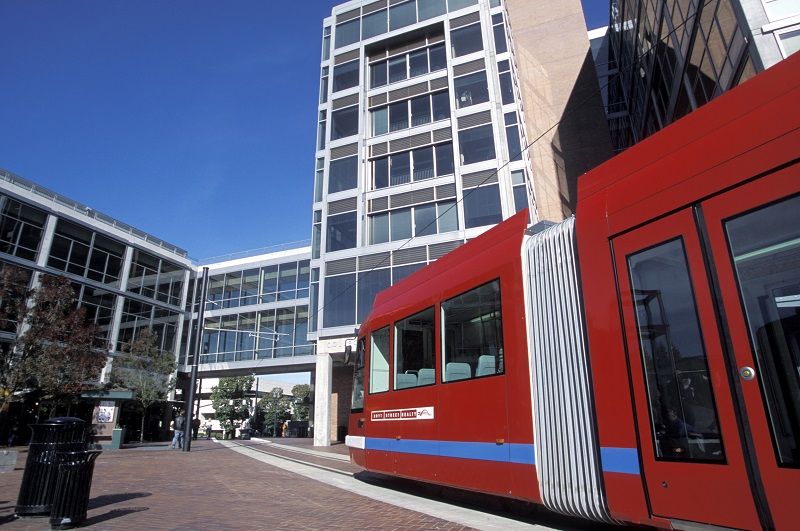
Executive Summary
During the past decade, Portland-area planners have embraced Transit-Oriented Development (TOD) as the dominant land use/transportation strategy. They assert that TOD, especially based on light rail, will reduce traffic congestion, increase transit use, improve air quality, and attract private investment.
Dozens of TODs have been constructed in the Portland region since 1990, with several winning national acclaim. Most have received public subsidies, on the assumption that the public benefits of TOD outweigh the costs. However, little is known about how transit-oriented projects actually perform once they are built, in terms of transit use and auto dependency. The purpose of this analysis—the first in a series of Portland, Oregon TOD case studies—is to begin filling in that gap by analyzing one of the most well-known TODs in the country, Orenco Station.
Orenco Station is located at the Orenco/ 231st stop of the Westside light rail line in Hillsboro, Oregon, about 15 miles west of Portland. The area was originally a large nursery, which went bankrupt in 1927. Most of the property was never developed and was eventually used primarily as a site for illegal dumping.
During the 1980s the city of Hillsboro created an urban renewal district to consolidate the land ownership and promote economic development. At the same time Oregon’s first light rail line had just opened on the east side of Portland and a Westside line was in the planning stages. The initial plans called for light rail to terminate at 185th Avenue, just to the east of the Orenco neighborhood. Rail advocates urged that the line be extended to downtown Hillsboro, and federal funding was secured for the initial planning.
After Hillsboro consolidated land ownership within the urban renewal district, large parcels were sold to two corporate entities: Intel and PacTrust. Intel invested more than $2 billion to construct the Ronler Acres campus about one mile north of the Orenco light rail station. PacTrust, a development firm, began planning a highdensity, mixed-use project nearby based on TOD principles.
TriMet and Hillsboro imposed extensive planning restrictions on the area, mandating high densities near the rail station that were strongly opposed by many existing residents. PacTrust partnered with Costa Pacific Homes and several other developers to build a mixed-use town center along Cornell Road (about 500 yards north of light rail), with various residential projects that included single-family homes, apartments, condominiums, townhouses and live/work row houses. West Hills Development subsequently bought an 82-acre parcel of land on the south side of the LRT station and is currently developing a highdensity residential project there.
Westside light rail opened in September 1998. Research for this paper looked at the development patterns near light rail and transit use to see if the alleged public benefits of TOD are being realized.
It is apparent that rail is not a catalyst for development. Most of the earliest construction took place adjacent to Cornell Road, while the land immediately surrounding the rail stop remained vacant. Within the past year West Hills Development has begun developing land south of light rail, but large parcels on the north side lie fallow.
In terms of transit use, Orenco Station has largely proven to be a disappointment. Most people who take the train from the Orenco/231st stop arrive there by car and take advantage of the free Park-n-Ride lot.
The expensive, pedestrian-oriented parkway that connects Orenco Station to the transit station is empty most of the time, despite the wide sidewalks, park benches, and decorative street lighting. The majority of Orenco Station residents live too far away from the transit station to walk there on a regular basis.
Three large employers—Intel, Sitel and Norm Thompson—provide free shuttles for their workers to get to and from the light-rail station. This inflates the ridership of light rail, but adds to local traffic and diminishes the alleged environmental benefits of rail transit. It also amounts to a private subsidy to the rail program.
Since light rail is not used by most nearby residents, development around the Orenco/ 231st station stop has dramatically increased local traffic. By the time the south-side project is built out by West Hills, there will be more than 12,000 additional daily auto trips on the local road system as a result of TOD.
TOD advocates generally assert that light rail is vital to the commercial success of nearby development. In fact, the various PacTrust projects, including the Orenco Station town center, the residential neighborhoods, and a nearby shopping center, have all come to fruition largely because they are auto-oriented and located on a five-lane arterial (Cornell Road).
Of all the public policies that have affected development in the Orenco neighborhood since 1980, the construction of light rail has been one of the least important. Other decisions were much more instrumental in jumpstarting development, including: the decision by Hillsboro to create an urban renewal district to consolidate land ownership; the decision by Intel to locate a facility within the district, thereby creating a critical mass of highly paid workers that could support upscale residential development nearby; and the upgrades to the local road system, including Cornell Road, Evergreen Parkway and Butler Road, which took previously land-locked parcels and allowed them to be available for commercial development.
Most of the development projects near the Orenco/231st station have been publicly subsidized. The rail extension itself cost taxpayers more than $190 million; a $500,000 Congestion Mitigation Air Quality (CMAQ) grant from the federal government paid for part of the TriMet Park-n-Ride; Hillsboro provided over $1,000,000 from its Traffic Impact Fund to compensate for infrastructure investments; and Metro spent $230,000 to pay TOD consultant Peter Calthorpe to do various design sketches for Westside light rail stations, including Orenco.
Based on the performance to date of the Orenco TODs, it is difficult to make the case that taxpayers should continue subsidizing such projects by paying for the three additional light rail lines TriMet and Metro want to build, or approving public giveaways such as property tax abatements. There is no evidence that TOD near Orenco lessens traffic or improves air quality, and many local residents do not feel that high density development improves their quality of life. Zoning is retarding land development north of the rail station due to high density mandates that are not financially feasible.
The experience at Orenco/231st suggests that policy makers should lower their expectations of what light rail and TOD can deliver in terms of public benefits.
About Cascade Policy Institute: Founded in 1991, Cascade Policy Institute is Oregon’s premier policy research center. Cascade’s mission is to explore and promote public policy alternatives that foster individual liberty, personal responsibility and economic opportunity. To that end, the Institute publishes policy studies, provides public speakers, organizes community forums and sponsors educational programs.
Cascade Policy Institute is a tax-exempt educational organization as defined under IRS code 501(c)(3). Cascade neither solicits nor accepts government funding and is supported by individual, foundation and business contributions. Nothing appearing in this document is to be construed as necessarily representing the views of Cascade or its donors, or as an attempt to aid or hinder the passage of any bill before any legislative body. The views expressed herein are the author’s own. Copyright 2006 by Cascade Policy Institute. All rights reserved.











